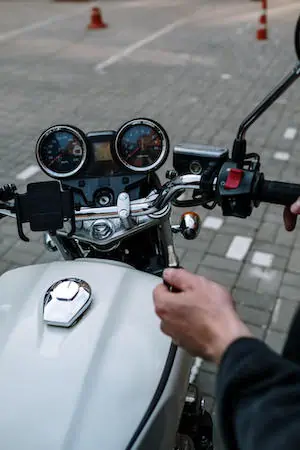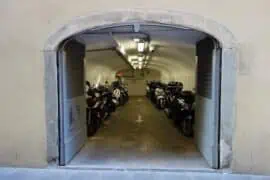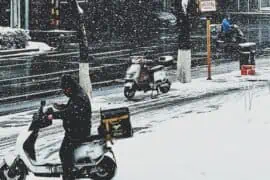Winter can be a brutal season for motorcycle riders in many parts of the United States. Even if the sun comes out, you might need to deal with icy roads and cold temperatures.
Instead of riding to relax, it becomes an experiment studying how much discomfort you can handle.
Didn't You Try Our Quote Comparison Tool Yet? Save BIG by Doing it!
Many riders decide to winterize their bikes when the cold weather arrives. Proper storage ensures that when it snows, the motorcycle stays protected when you’re ready to explore again.
If you’re prepping for the cold season, you can use this guide as a winterized motorcycle checklist to ensure your equipment receives protection.
Table of Content
- Do I Need to Winterize My Motorcycle If I Still Ride It?
- Can You Leave Gas in a Motorcycle Over the Winter?
- How Do I Winterize a Fuel-Injected Motorcycle?
- Should I Remove My Battery for the Winter?
- How Often Should I Start My Motorcycle During Winter Storage?
- What Happens If You Don’t Winterize a Motorcycle?
- What Is the Best Way to Winterize a Motorcycle?
Do I Need to Winterize My Motorcycle If I Still Ride It?
Although you can skip a full winterization if you plan to ride your motorcycle, it helps to follow some practices to protect your equipment.
- Maintain Your Fluids. Please pay attention to your coolant because it quickly turns acidic in cold weather. You’ll want to check on everything else throughout the season when riding to ensure everything operates as expected.
- Wax and Wash. More salts tend to be on winter roads, which means dirt and grease can become highly corrosive. After you take a long ride, give the bike a good wash. Once it is dry, wax it to help repel de-icing agents.
- Treat Your Fuel. This step is essential each time you return after riding in cold weather.
Once you’ve filled the tank with fuel and an additive, It helps to run the motor outside so the new gas makes its way to the intakes and injectors.
As a final step, consider waxing the chain while the motorcycle is still warm to reduce the effects of saltwater on the metal.
Can You Leave Gas in a Motorcycle Over the Winter?

Note that:
It only takes 30 days for ethanol-blended fuels to go bad. When you incorporate a stabilizer, the gas stays fresh for up to two years.
That’s why this technique is the easiest way to winterize a motorcycle gas tank.
The best way to complete this step is to ride the motorcycle to the gas station. Add your preferred stabilizer to the tank, fill it with fresh fuel, and ride home. This process circulates the mixture throughout the bike to protect it for the winter.
How Do I Winterize a Fuel-Injected Motorcycle?
Motorcycle winter storage for fuel-injected bikes differs slightly from those with a simple carburation design. You’ll want to take the following steps to have a successful experience.
- Get the fuel tank as empty as possible through regular riding activities. Add a high-quality gas stabilizer, fill it up, and ride the bike home.
- If you’re more than halfway to the following scheduled oil change for the motorcycle, take the time to change it to prevent impurities from staying in the engine all winter.
- Block the airbox inlet and muffler with plastic and a strong holder to prevent pests from living in the motorcycle after the temperatures drop. This step also seals moisture that could damage your cylinder walls and valves.
Most modern motorcycles use fuel injection technology, but older bikes often have a carburetor. If you have a vintage or a classic, you’ll need to take different steps to prepare for the season.
Knowing how to winterize a carbureted motorcycle means draining the fuel tank entirely. All water and contaminants must be eliminated. Then you can refill the tank to total capacity with a stabilizer or leave it empty.
If you need to add the stabilizer, top it off and ride the bike for about 30 minutes. Then let the motorcycle settle for a few days before rerunning the engine. Your other option is to empty the tank, then add the stabilizer and new fuel.
Should I Remove My Battery for the Winter?
You should take the battery out when you store your motorcycle for the winter without plans to ride it for more than 30 days. If you expect a nice day and want to do some riding, try disconnecting the negative cable instead of removing the entire assembly.
This step prevents any of your motorcycle accessories from draining power from the battery.
After you’ve taken this winterization step, it helps to check your cables and posts for corrosion issues. If you discover problems, use a wire brush with a baking soda and water mixture to clean it.
Once your posts, connectors, and cables are clean, coat the terminals and posts with silicone grease for extra protection.
Motorcycles with lead-acid batteries should have fluid levels checked monthly while in winter storage. If it drops beneath the fill line or below the lead plates, use distilled water to restore balance.
If you need to charge your motorcycle battery in the spring, please remember to do so outside or in a well-ventilated spot. This process releases hydrogen sulfide, which is toxic to humans and flammable.
How Often Should I Start My Motorcycle During Winter Storage?
Some motorcyclists recommend starting the bike at least once per week during the winter and letting it run for a few minutes. If you take this step, please remember to open the windows or garage doors to prevent inhaling the exhaust.
Instead of taking this step, you can invest in a battery tender to manage your charge levels throughout the winter. A trickle charger also helps everything stay ready when it’s time to ride again.
Some experts believe a battery tender should be used throughout the year to prolong longevity. Prices are typically between $40 to $130.
If you winterize your motorcycle and it doesn’t start in spring, you could have forgotten your pin. It is also possible that the fob battery ran out of power because it attempts to communicate with the bike throughout the season. It likely needs to be replaced before your first ride.
What Happens If You Don’t Winterize a Motorcycle?
If you don’t winterize your motorcycle and decide to store it for the winter, you’ll likely discover deposits in the fuel system. The oil tends to get thick and sludgy, while the chain becomes slightly brittle.
When your bike is exposed to winter precipitation, the tires lose air pressure. They might even crack if the conditions are extreme.
The motorcycle battery may fail to work. Cold temperatures can cause a parasitic drain that reduces cranking power if it isn’t getting a normal charge. This issue can even lead to it freezing if the charge levels and temps get too low.
What Is the Best Way to Winterize a Motorcycle?
The best way to prepare a motorcycle for winter is to follow the manufacturer’s instructions for this process. Most companies provide materials, either online or in your manual, that outline the best practices to follow.
When you take care of a motorcycle in the winter, it will be ready to ride when the weather turns warm. Follow the steps outlined in this guide, and you’ll be able to respond when the open road offers its invitation once again.
Some motorcycle insurance policies might not cover storage-related damage if it develops from neglect. You’ll also want to talk about the pros and cons of seasonal coverage with your agent or request a quote for this protection to ensure you’re paying only what you should be for your coverage.
Also, figure out if canceling the insurance during the winter months only help to save you money or not.
Use This Tool for Free and Save on Quotes!






